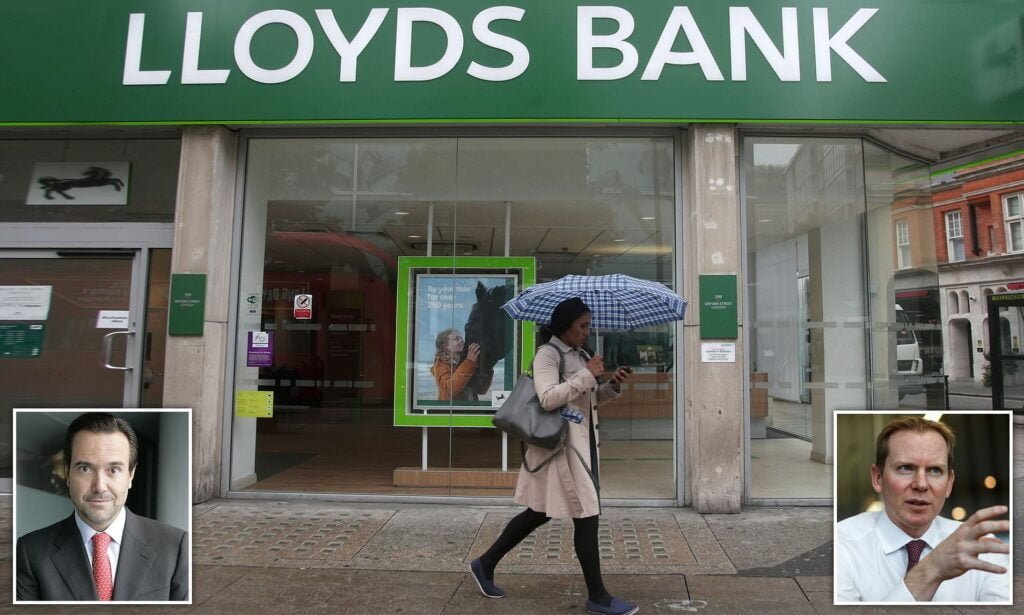Lloyds Bank Profits Plunge Amid Mortgage Competition
Lloyds Banking Group, one of the largest banks in the UK, has reported a 28% drop in profits in early 2024. The decline in pre-tax profits, from £2.3bn to £1.6bn, was primarily attributed to increased competition in the mortgage market. Lenders are vying to offer better deals to squeezed buyers, resulting in reduced margins for Lloyds.
The mortgage market has become fiercely competitive, with banks and other financial institutions aggressively trying to attract borrowers by offering lower interest rates and more flexible terms. This intense competition has put pressure on Lloyds, which has traditionally been a dominant player in the mortgage sector. As a result, the bank has had to lower its rates and offer more favorable terms to stay competitive.
Furthermore, the economic landscape has also played a role in Lloyds’ declining profits. The uncertainty surrounding Brexit and its potential impact on the housing market has made both lenders and borrowers cautious. Many potential homebuyers are adopting a wait-and-see approach, delaying their property purchases until there is more clarity on the future of the UK’s relationship with the European Union.
In addition to the challenges in the mortgage market, Lloyds has also faced a decrease in profits from loans to businesses. The ongoing economic uncertainty has made businesses more reluctant to take on additional debt, leading to a decline in demand for business loans. This has affected Lloyds’ bottom line, as the bank earns significant revenue from interest charged on these loans.
However, it’s not all doom and gloom for Lloyds. The bank has managed to offset some of the decline in profits by capitalizing on other areas of its business. Profits from credit cards and car finance have increased, as consumers continue to rely on these forms of borrowing. Lloyds’ credit card division has seen growth in customer numbers, with more people using credit cards for everyday purchases and taking advantage of rewards programs.
Additionally, the bank’s car finance division has experienced a surge in profits, as more individuals opt for financing options when purchasing vehicles. This trend can be attributed to the rising cost of cars and the desire for individuals to spread the cost over a longer period. Lloyds has been able to tap into this market and generate higher profits from its car finance offerings.
In conclusion, while Lloyds Banking Group has faced significant challenges in the mortgage market and business lending, it has managed to mitigate some of the decline in profits through its credit card and car finance divisions. The bank will need to continue adapting to the changing landscape of the financial industry and finding new avenues for growth to regain its position as a top performer in the UK banking sector.
Heightened Competition in the Mortgage Market

Lloyds Bank stated that its net interest income, the difference between the money generated from loans and the amount paid out for deposits, fell by 10% to £3.2bn in the first quarter of 2024. This decline was anticipated as more individuals moved their cash into savings accounts with higher returns. Additionally, mortgage rates eased due to the intensified competition among lenders.
Russ Mould, Investment Director at AJ Bell, commented on the situation, saying, “The company has seen competition in the mortgage market bring down its returns and savers move deposits into higher interest accounts – meaning it is paying out more to customers.”
The heightened competition in the mortgage market can be attributed to several factors. Firstly, the low interest rate environment has encouraged more borrowers to enter the market, seeking favorable terms and conditions. This influx of borrowers has created a surge in demand for mortgages, leading to increased competition among lenders to attract these potential customers.
Furthermore, the rise of digital platforms and fintech companies has disrupted the traditional banking landscape. These new players in the market offer streamlined processes, lower fees, and innovative products, making them attractive alternatives to traditional banks. As a result, established banks like Lloyds are facing increased competition not only from their traditional rivals but also from these emerging fintech companies.
In response to this heightened competition, banks like Lloyds are forced to lower their mortgage rates to remain competitive. This puts pressure on their net interest income, as the difference between the interest earned on loans and the interest paid on deposits narrows. As mentioned by Russ Mould, Lloyds is paying out more to customers in the form of higher interest rates on deposits, further impacting their net interest income.
Moreover, the shift in consumer behavior towards higher interest savings accounts has also contributed to the decline in Lloyds’ net interest income. As individuals seek better returns on their savings, they are moving their cash into accounts that offer higher interest rates. This trend has forced banks to raise the rates they offer on savings accounts, reducing the spread between the interest earned on loans and the interest paid on deposits.
Overall, the heightened competition in the mortgage market, driven by factors such as low interest rates, the emergence of fintech companies, and changing consumer preferences, has had a significant impact on Lloyds Bank’s net interest income. As the competition continues to intensify, banks will need to find innovative ways to differentiate themselves and attract borrowers while maintaining profitability in a challenging market environment.
As interest rates continue to rise, Lloyds and other banks in the UK are facing the consequences of this shift in the lending landscape. While Lloyds had previously benefited from the increase in interest rates, allowing them to charge higher interest rates on loans and ultimately boosting their profits, the situation has now changed.
With the Bank of England raising its base interest rate to combat inflation, borrowing costs have also increased. This means that Lloyds and other lenders are now facing higher costs when borrowing money themselves, which in turn affects their profitability. The advantage that Lloyds once had when interest rates sharply increased has now come to an end.
One of the main challenges that Lloyds is currently facing is the more competitive mortgage market. As interest rates rise, potential homebuyers are becoming more cautious about taking on large mortgages. This has led to a decrease in demand for mortgages, which directly impacts Lloyds’ ability to generate revenue from this sector. Additionally, other banks and lenders are also vying for a share of the mortgage market, intensifying the competition for Lloyds.
Furthermore, the changing interest rate dynamics also pose a challenge for Lloyds. As interest rates continue to rise, it becomes more expensive for borrowers to take out loans. This can lead to a decrease in demand for loans, as individuals and businesses may be more hesitant to borrow money. As a result, Lloyds may experience a decline in loan origination, which can further impact their profitability.
To navigate these challenges, Lloyds will need to adapt its lending strategies and find new avenues for growth. This may involve exploring other types of loans or diversifying their business to reduce reliance on the mortgage market. Additionally, Lloyds will need to closely monitor the interest rate environment and adjust their pricing and lending policies accordingly.
Overall, the impact of interest rate increases on Lloyds and other banks in the UK is multifaceted. While they initially benefited from the rise in interest rates, the current scenario presents new challenges that require careful navigation and strategic decision-making.
Industry Outlook and Other Financial News

Heathrow Airport, the largest airport in the UK, reported a significant increase in profits before tax of £189m for the first quarter of 2024. This marked a turnaround from the £60m loss recorded during the same period last year. The airport attributed the growth in profits to increased passenger traffic, particularly on business routes to Delhi and Mumbai in India, as well as strong North American traffic. Heathrow Airport anticipates a busy summer season and has implemented an operating plan to ensure smooth operations.
In the travel industry, holiday firm Jet2 announced that its summer season is 55% sold so far. The company reported a 13% increase in forward bookings for package holiday customers and over 18% growth in flight-only passengers.
Despite the challenges faced by the travel industry due to the COVID-19 pandemic, Heathrow Airport’s impressive financial performance reflects the gradual recovery in air travel. With the easing of travel restrictions and the increasing number of vaccinated individuals, passenger traffic has started to rebound. The surge in profits can be attributed to the resumption of business travel to key international destinations such as Delhi and Mumbai, which are major economic hubs.
Moreover, the strong North American traffic has also contributed to Heathrow Airport’s financial success. The airport has witnessed an upswing in travelers from the United States and Canada, as people are eager to reconnect with family and friends or resume business activities. The steady growth in passenger numbers has prompted Heathrow Airport to implement an operating plan to ensure that operations run smoothly during the anticipated busy summer season.
In addition to Heathrow Airport’s positive performance, the travel industry as a whole is showing signs of recovery. Jet2, a popular holiday firm, has reported encouraging figures for its summer season. The company has already sold 55% of its holiday packages, indicating a strong demand for travel and tourism. This is further supported by a 13% increase in forward bookings for package holiday customers, highlighting the growing confidence among travelers to plan and book their vacations in advance.
Furthermore, Jet2 has experienced significant growth in flight-only passengers, with an impressive 18% increase. This suggests that more individuals are opting for flexible travel arrangements, choosing to book flights separately from accommodation and other services. The rise in flight-only passengers could be attributed to various factors, including the desire for more control over travel plans and the availability of competitive flight deals.
Overall, the positive financial performance of Heathrow Airport and the promising outlook for the travel industry indicate a gradual recovery from the impacts of the pandemic. As vaccination rates increase and travel restrictions continue to ease, it is expected that the industry will witness further growth in passenger numbers and revenue. The resilience and adaptability of companies like Heathrow Airport and Jet2 demonstrate their ability to navigate through challenging times and capitalize on emerging opportunities in the evolving travel landscape.
















